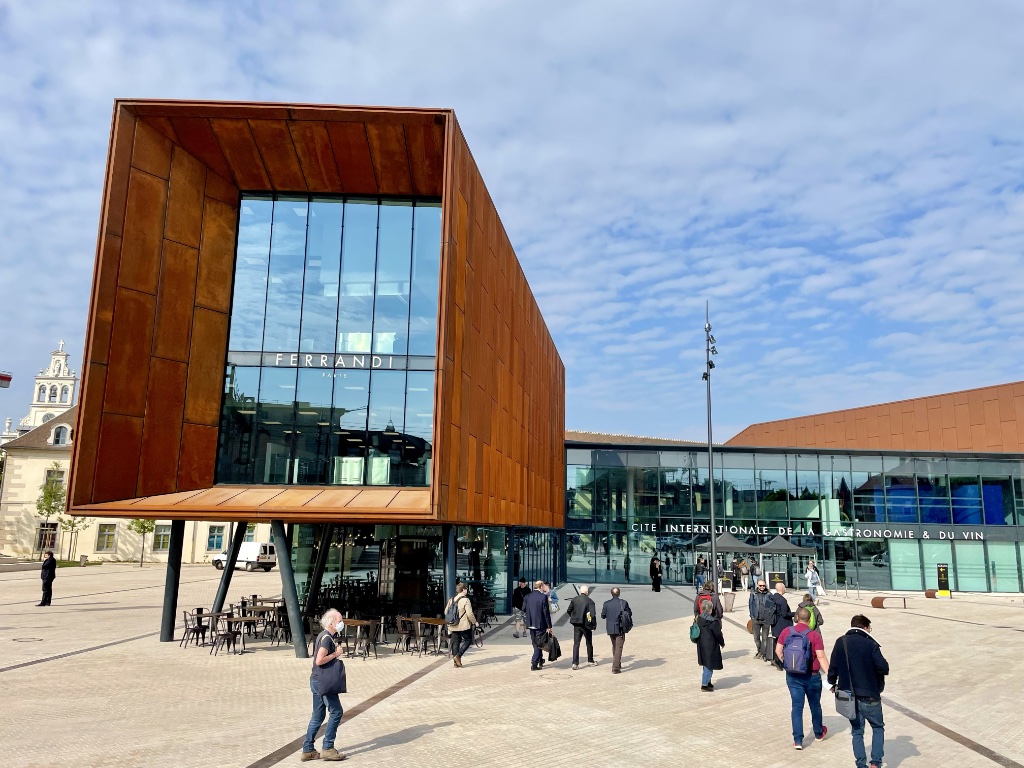
There is much more to Dijon than mustard. That’s the point the city seems to be making with its ambitious new project, the Cité Internationale de la Gastronomie et du Vin (International Gastronomy and Wine Center), which opened at the beginning of May.
The sprawling 16-acre complex is set on the site of the city’s former general hospital, originally founded in 1204 by Eudes III, Duke of Burgundy, and incorporates some of the buildings dating from the 15th to 18th centuries, but on arrival, visitors are greeted by a starkly modern building, designed by Anthony Bechu and Alain-Charles Perrot, with a rust-colored cantilevered wing jutting out rather aggressively. It houses the international program of the Paris-based Ferrandi cooking school, which has produced many a great chef over its hundred-year history.
Beneath it is a large café/brasserie/fine grocery, the Comptoir de la Cité, with a menu devised by three-star chef Éric Pras of the Maison Lameloise.
The other side of the building houses the entryway and a museum whose permanent exhibition, “Repas Gastronomique des Français,” explains the evolution of French cuisine, while a year-long temporary exhibition “C’est Pas du Gâteau, les Secrets de la Pâtisserie Française” focuses on French pastry, with spaces set up like pastry shops with clever paper cutouts for the desserts. Personally, I’d rather visit a real French pastry shop, but my favorite part of the show was the section called “Je Me Souviens” (“I Remember”), to which individuals contributed a pastry-making utensil and the memories attached to it. Twenty-one-year-old Arthur, for example, says of a baking tin:
“I remember being fascinated by this object. It was stored away at the back of the jam cupboard and never brought out until the day a friend of my mother’s was visiting and decided to make her specialty for us: sponge fingers sprinkled with sugar. They were so delicious, so crunchy – they melted in your mouth! It’s such a precious memory that I’ve never tried to bake any myself.”

Beyond the new building is the Village Gastronomique, a kind of outdoor shopping mall for gourmet food and wine, with boutiques specializing in artisanal coffee, pastry, chocolate, cheese, meat, charcuterie, mustard and tableware. There is also a cookbook shop (the Librairie Gourmande, which also has a store in Paris). La Cuisine Expérientielle, with a rooftop terrace and a barbecue pit, is the site of cooking demonstrations and courses, masterclasses and other food-related events.
L’École des Vins de Bourgogne offers tastings, workshops and courses on Burgundy wine, while the gourmet restaurant La Table des Climats, located next to the former hospital’s Chapelle des Climats (where an immersive exhibition on local vineyards and gastronomic heritage is held), specializes in pairings of the best Burgundy vintages with seasonal dishes.

The main attractions of Dijon for most tourists are still the city’s beautiful historic center and the Palace of the Dukes of Burgundy, but while I was there for the opening of the Cité Internationale de la Gastronomie et du Vin, I discovered a treasure of another variety, the Consortium Museum, with its cutting-edge exhibitions of contemporary art and its handsome building designed by Shigeru Ban. In 2016, The New York Times called it “the under-the-radar French museum that quietly predicts art’s next big thing.” The museum will reopen on June 11 and present five new exhibitions over the summer.
Favorite